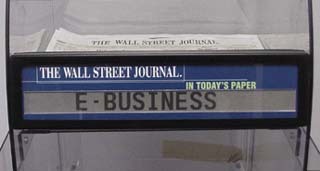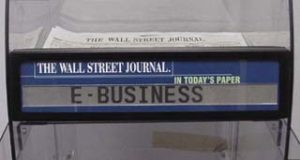Electric Signs
Smart Paper IQ Is Rising
Full-color programmable billboard introduced in Jerusalem
Published
18 years agoon

Somewhere outside of Jerusalem, a color billboard measures approximately 10 x 12 ft. With the exception of a faint grid pattern every 6 in. or so, it looks like any other billboard promoting a fast-food chain. Then, suddenly, the message changes to an ad for a luxury watch…then to an ad for a car. Momentarily, the image of the car morphs: same car, different color. What kind of billboard is this? We might hastily conclude it’s a revolving, electro-mechanical, three-face unit, except this sign has no moving parts, and none of the images have been printed. Or, we might momentarily believe it’s an electronic LED matrix, but then we see that this is a reflective sign, illuminated by two, standard overhead floods. This billboard is, in fact, a prototype of a new electronic-display technology based on full-color programmable media from Magink (formerly E-magin), based in Neveh-Ilan, Israel. Developed over the past four years in Israel and the U.K., the Magink display face falls into the emerging category of smart paper, also known as e-ink, reusable sign media or e-paper. It works like this In terms of science, the Magink display core is a paste that changes the color wavelength and density of the light that it reflects in response to the electronic signal it receives. The paste is applied to a thin sheet of glass or a flexible plastic in a process similar to fabricating a printed circuit board; then another layer of substrate is applied on top, forming a sandwich. When an electrical field is transmitted through the upper and lower layers, it transforms the core paste at that point or "domain." The image total is formed by a matrix of "domains," or pixels, each of which is prompted by the electronic signal to reflect the appropriate color. When the signal is removed, the image remains fixed until a new set of signals is sent. The Magink product touts very low energy usage. Magink president and founder Ran Poliakine acknowledges the abstractness of this technical explanation and, quite frankly, it wouldn’t make any more sense to me if he shared the actual formulations or engineering drawings. What does matter is whether it works, and, having seen a series of photographs of the prototype, I say it does. According to Poliakine, the brightness is approximately 70%, not as good as the best paper, but comparable to an outdoor vinyl. In other words, Magink is "reflective" in the same sense that an inkjet-printed billboard image is; the more light, the better the visibility. Although the Magink prototype product compares in resolution to a 300-dpi color image, the company plans to introduce a lower-resolution display for the out-of-home market as its first commercial product. The billboard material will have a 5mm pixel pitch and viewing distance of approximately 25 ft. In terms of color, the display will produce 4,096 total color shades or 16 gray levels per color channel. The two standard formats initially available will be 10 x 12 ft. and 10 x 24 ft. Magink says the units will withstand virtually any temperature range on the inhabited portions of the planet, and are also highly UV resistant. Where it’s going According to Marketing VP Don Davidson, the company will launch the product into the outdoor advertising market in 2003, but is planning on installing four European and North American test units before the end of this year. According to Davidson, three "household-name" media companies have already agreed to participate in the beta phase. What it costs As a billboard technology, we can look at Magink two ways: as an inexpensive competitor to an LED matrix, or an expensive competitor to a conventional inkjet-imaged billboard. Currently priced in the $300-$500/sq.-ft. range, a Magink billboard commands approximately 10% of the cost of an LED sign of similar size and resolution. This is something of an apples and oranges comparison for a few reasons. First, an LED sign is emissive rather than reflective; second, an LED can run full-motion video, which Magink can’t yet do. However, Davidson points out some special advantages of Magink vs LED. "Advertising agencies often balk at the need to prepare special content for LED signs," he says. "They’re also concerned that LED signs, other than those in dense foot traffic areas, have a slim chance of the full message being seen." On the other hand, the Magink billboard can deliver a static image in a standard JPEG format that is typically less than 1 MB. Conversely, if we look at a smart-paper billboard compared to a conventional printed sign, we have a somewhat different scenario. The first overwhelming fact is the high initial cost of outfitting a billboard with Magink. Using the company’s estimate, we see that a 10 x 12 ft.-unit could cost well over $50,000 to install. On the other hand, Magink eliminates the cost of printing and installing new graphics. Other benefits Smart billboards potentially offer a significant revenue boost, simply because a smart billboard can run as many ads as can be sold. This particular windfall is purely theoretical. Advertising dollars are finite, and their usage can’t be predicted. But we do know that approximately 80% of the existing billboard capacity is controlled by a handful of companies, whose interests also include broadcast media. A final benefit versus static billboards: Changing images on a smart billboard will attract the viewer’s eye, so the message has a better chance of being seen. Billboards are only one segment of the sign industry and a rather consolidated one at that. Unless you have business in this particular niche, you may find this report mildly interesting but irrelevant. Don’t wonder. More smart-paper technology is coming your way, both from Magink and competitors. At least two of these competitors already sell programmable displays. More e-mergence The two other high-profile contenders in smart-paper technology are E-Ink Corp. (Cambridge, MA) and Gyricon (El Segundo, CA). The technologies are similar in some ways, but different (if you want to know more, visit www.e-ink.com and www.gyricon.com). Both are reflective technologies based on thin-plastic display media that can display reflective monochrome images. Powered by batteries, they’re essentially portable. Rumors of this technology have been circulating for several years, but now we’re seeing some actual products. E-Ink and Gyricon are now selling products to international brands and retailers. E-Ink was developed by brilliant guys at MIT. E-Ink Corp., founded in 1997, currently offers two commercial products, Ink-In-Motion and a segmented character display intended for signage and digital appliances. The Ink-In-Motion material is essentially a POP solution, for which E-ink Corp. programs changeable text, graphics and limited animations. Other colors can be added to the changeable display by designing color templates into the presentation. Coca-Cola incorporated Ink-In-Motion media into 200 promotional displays at the 2002 Winter Olympic Games in Salt Lake City. Gyricon’s SmartPaper™ technology was developed by brilliant guys at Xerox’s legendary PARC center in Palo Alto, CA. In Part One of this series (see ST, April, page 62), I referred to an important Gyricon pilot project in Bridgewater, NJ, in which Macy’s East tested 12 changeable pricing signs in a children’s department. Content was changed via a wireless network. Meanwhile, Gyricon SmartPaper is being incorporated into various standalone sign applications. A recent example is a sign component for 85 Wall Street Journal and Barron’s newspaper vending boxes in Houston (see photo). The sign contains a very small, integrated controller programmed to change the text daily to promote the newspaper’s feature section. Currently, Gyricon is preparing to release standalone sign units, which can be pre-programmed with a changeable set of finite messages in a manner similar to the Wall Street Journal project. Becoming active matrix displays will take both of these technologies to the next level. This means they will be "all points addressable" at the pixel level and function essentially as a very thin version of a CRT, LCD or plasma display. According to Gyricon’s Chief Technology Officer, Dr. Robert Sprague, this process anticipates the continued evolution of manufacturing methods for the transistorized "backplanes" that will ultimately drive the flexible papers like a plasma screen. E-Ink has announced an active matrix product (with a target year of 2004) that is said to be thinner than a credit card. E-magining the future How fast can a disruptive technology like Magink (or E-Ink or Gyricon) change an industry? We never know for sure, but we have at least one historical precedent to give us perspective. Consider that the first digitally printed billboard face was installed circa 1990 and was probably output from a EFI 1630 computer-airbrush machine. If you recall that pioneering technology, the resolution was 18 ppi, and the dots were the size of your kid’s thumbprint. While the photo-images were acceptable at longer viewing distances, the text copy was usually cut separately out of vinyl and applied in the appropriate position. Yet 12 years later, virtually all billboards are printed on superwide inkjet printers. What drove the inkjet metamorphosis was simple: copy turnaround and economics. Billboard content could suddenly be printed and changed in a matter of days, and even single-copy jobs were inexpensive to print. Smart billboards simply represent the next phase in this process: even faster image turnaround and theoretically lower costs of "printing." Consider that billboard owners have the financial resources to retrofit billboards and that they’re plugged into the advertising community. Then assume there are no huge landmines (such as regulatory issues?) buried along the way. Do you think it will take 12 years?

SPONSORED VIDEO
Introducing the Sign Industry Podcast
The Sign Industry Podcast is a platform for every sign person out there — from the old-timers who bent neon and hand-lettered boats to those venturing into new technologies — we want to get their stories out for everyone to hear. Come join us and listen to stories, learn tricks or techniques, and get insights of what’s to come. We are the world’s second oldest profession. The folks who started the world’s oldest profession needed a sign.
You may like

Church Sign Found After Being Stolen From Cemetery

PRINTING United Alliance Forms Strategic Partnership with ASI

The Joy of Working
Subscribe

Bulletins
Get the most important news and business ideas from Signs of the Times magazine's news bulletin.
Most Popular
-

 Photo Gallery1 week ago
Photo Gallery1 week ago30 Snapshots of the 2024 ISA Sign Expo
-

 Ask Signs of the Times2 weeks ago
Ask Signs of the Times2 weeks agoWhy Are Signs from Canva so Overloaded and Similar?
-

 Paula Fargo7 days ago
Paula Fargo7 days ago5 Reasons to Sell a Sign Company Plus 6 Options
-

 Real Deal4 days ago
Real Deal4 days agoA Woman Sign Company Owner Confronts a Sexist Wholesaler
-

 Benchmarks2 weeks ago
Benchmarks2 weeks ago6 Sports Venue Signs Deserving a Standing Ovation
-

 Photo Gallery7 days ago
Photo Gallery7 days ago21 Larry Albright Plasma Globes, Crackle Tubes and More
-

 Women in Signs2 weeks ago
Women in Signs2 weeks ago2024 Women in Signs: Brandi Pulliam Blanton
-

 Women in Signs1 week ago
Women in Signs1 week ago2024 Women in Signs: Alicia Brothers












